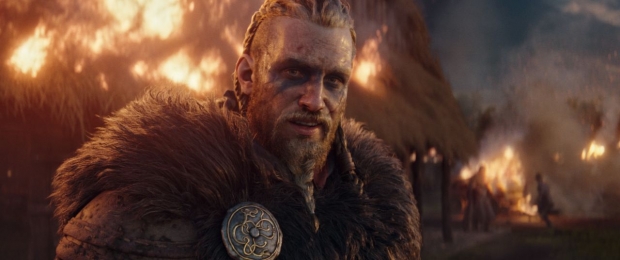VFX studio Goodbye Kansas’ Jonas Skoog and Goran Milic share their insights on the pipeline, tools, and ongoing development needed to create CG humans that look real and emote believably.

Eivor, digital human character produced by Goodbye Kansas for the 'Assassin's Creed Valhalla' cinematic TV spot. Images courtesy of Goodbye Kansas.
Approaching the creation of a realistic digital human involves understanding how to create context-based behaviors, which allow the “human” to move and emote believably. Human faces, even in digital form, elicit strong emotions. The process to create a digital human can involve a high level of technical skill and the use of multiple software programs.
Goodbye Kanas Studios, a visual effects studio based in Sweden and London, has developed considerable skill and expertise in creating digital humans. Goodbye Kansas’ Jonas Skoog, lead character artist, and Goran Milic, head of facial animation, shared some of their insights – and digital human creation secrets - including their experience working on the 2020 role-playing action game, Assassin's Creed Valhalla.
First, check out the game’s cinematic TV spot:
The "human" toolkit
In their streamlined approach to the creation of digital humans, Milic and Skoog credit Maya as their main tool for rigging and animation. For the animation process, they focus on the details of the digital human. “We use Substance Painter and Mari for the texture works,” Skoog explained. “We use V-Ray as our main render engine for the frames, and we use Houdini as a grooming software to do the hair. We use so many different small pieces of software.”
In bringing the characters in the Assassin's Creed Valhalla trailer to life, the Goodbye Kansas team worked on animating the face and body of the main character, Eivor, to fit the original performance capture. However, the process of lip-syncing had to be redone to fit another actor's voice, when the original casted actor for Eivor could not attend the main performance capture session. The Goodbye Kansas team had to manually redo the lip-syncing for the lower face based on the new audio recording.
“We go on to polish, polish and polish”
As to working to mitigate the missing information for the look and shading of the character, Skoog explained their approach: “There was another trailer done with the same character before the one we did for Valhalla. We realized we could match one performance to another. We couldn't stray too far away from the look of the digital human in the previous trailer, but we still wanted to make this one look better or as good as we could. The aim was to align the development of the character in this one to the previous trailer.”
While information gaps make the creation of digital humans more challenging, Goodbye Kansas has refined its pipeline and added resources, including a library of shapes, to help them manage these particular challenges. Often managing these problems takes a great deal of manual work. “For the character in Assassin’s Creed Valhalla,” Milic noted, “the facial rhythm could be worked upon continuously until the project was done.” When facing challenges, a judgment call needs to be made. Milic had worked with the client before on previous trailers and knowing their expectations for the game, could judge when they had worked on the facial rhythm enough.
Check out Goodbye Kansas’ Assassin’s Creed Valhalla cinematic TV spot behind-the-scenes:
“You’ll see if something’s off, it could be startling”
Goodbye Kansas’s strategy facilitates ongoing improvements in the creation of digital humans. This strategy includes a small team to “create new tools and look into how we can get better results,” said Skoog. For example, the team has acquired a scanner. In explaining the importance of this tool, Skoog shares, "Our in-house scanner allows us to have control of the results. It's much easier to request all the details from a scan when you have it in-house, in comparison to an outsourced scan. Sometimes it's hard to request extra parts like the HDRI [high dynamic range image] with references of the scan session so we can determine what the actual specular highlights look like under a lighting condition.”
For Skoog and Milic, there is no tool or technology they would say is the “best” to use when creating these humanoid avatars. In fact, there are plenty of opportunities for development in the technology used for creating digital humans. Skoog commented, “Different renderers have different capabilities, and in working with just one, you cannot have all the capabilities of all of them. Skin shading might be lacking in one, but the toolset is better in another. As for Goodbye Kansas, we are looking deeply into universal screen description to have a unified pipeline for all types of software. That will be a major leap in the 3D business as a whole.”
“We evolve all the time and get better”
Goodbye Kansas has built a reputation for creating great digital humans; their work on Assassin's Creed Valhalla amply demonstrates their talents as a studio. One thing Skoog and Milic emphasize is how much a developed pipeline is critical to facing challenges or information gaps, as well as ensuring efficiency in the digital human creative process.
Goodbye Kansas’ pipeline includes a facial scanner and body scanner in-house, invaluable items in its toolkit. But as the pair note, developing great digital humans also takes artistic expertise; the marriage between creative intuition and high-quality tools, matched with the expertise and experience of the team, makes it possible to quantify how much work must be done to achieve great results for clients.
Goodbye Kansas continues to push the boundaries of creativity by harnessing the right technologies to tell engaging stories with digital humans. The Assassin’s Creed Valhalla trailer went on to win NYX and Vega awards.









